Here’s a simple and accessible Giro d’Italia guide which starts on Friday. There’s a concise preview of every stage below as well as explainers on the rules for the mountains and points competitions; TV guide and more.
This is a blog post but you can find a copycat page for easy reference over the next few weeks at inrng.com/giro or go to the menu bar at the top of the page and the “Giro” tab if you’re browsing via desktop/big screen or use the drop down menu if you’re on a phone and select “Giro”.
Route summary
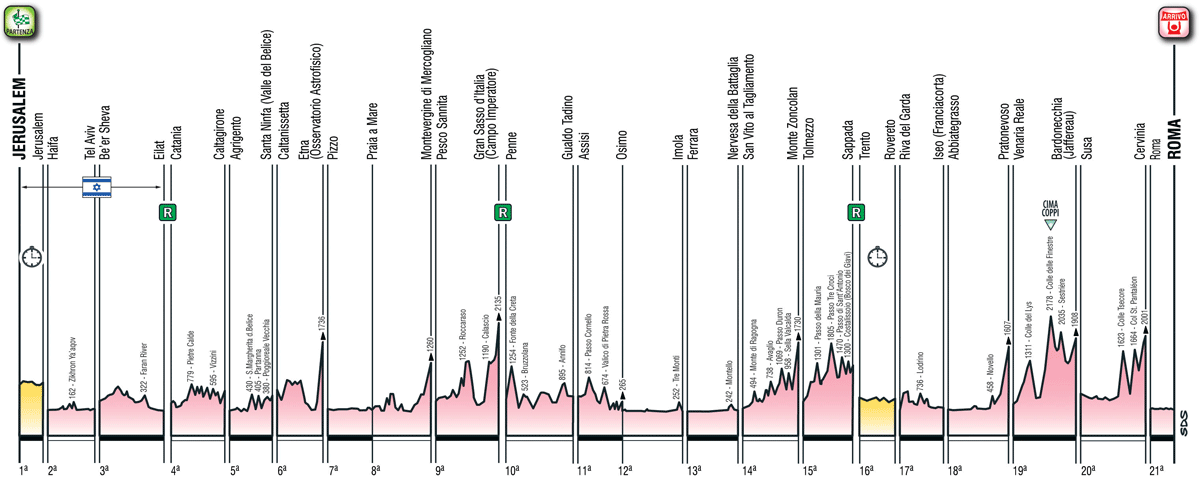
In a word: steady. Many long and linear climbs to ski stations and a flat time trial stage, a route tilted toward riders like Tom Dumoulin and Chris Froome but there are some stages in ambush territory starting with the three in Sicily. There are few pure sprint stages, several are spiced up by a late hill so the points jersey is likely to go a versatile sprinter rather than a dragstrip demon.
Now on to each stage. Note the annotations where TV = Traguardo Volante or Intermediate Sprint and R = Rifornimento or Feed Zone.
Stage 1 – Friday 4 May
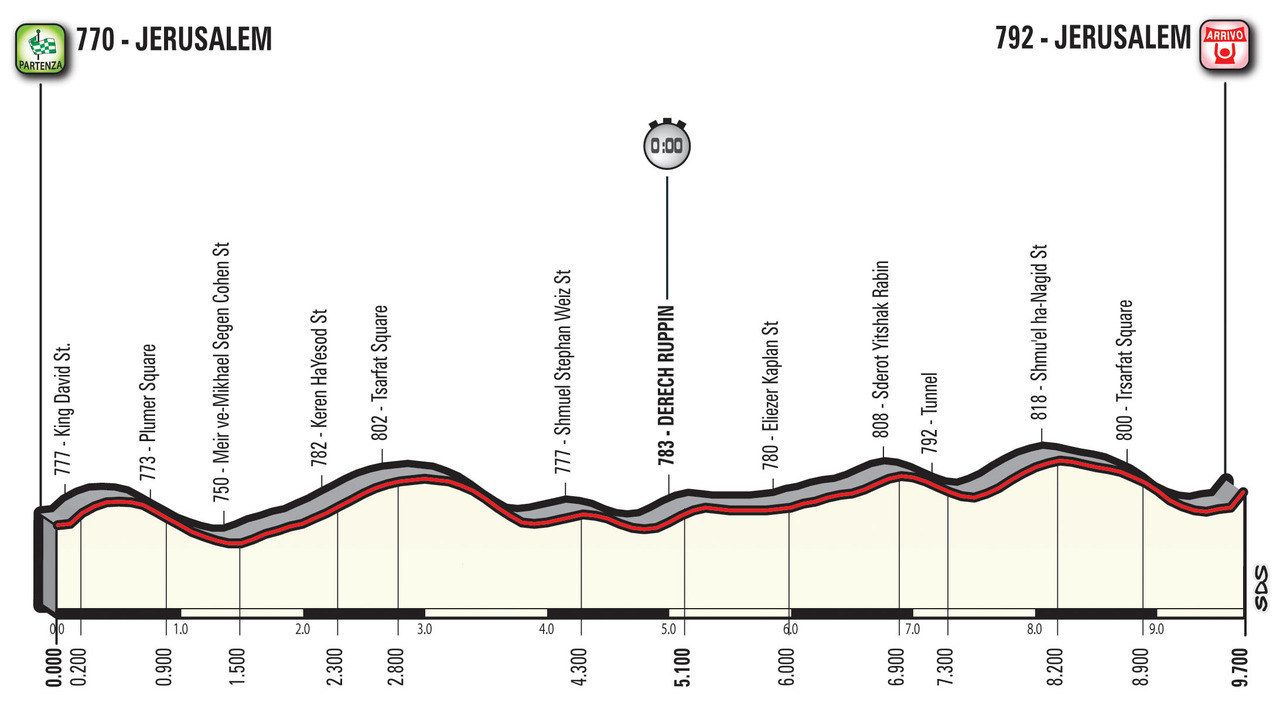 The profile says it all, this is a lumpy opening time trial with long steady drags of 3-4% along big avenues before a sharp kick up to the finish line for the final metres.
The profile says it all, this is a lumpy opening time trial with long steady drags of 3-4% along big avenues before a sharp kick up to the finish line for the final metres.
Stage 2 – Saturday 5 May
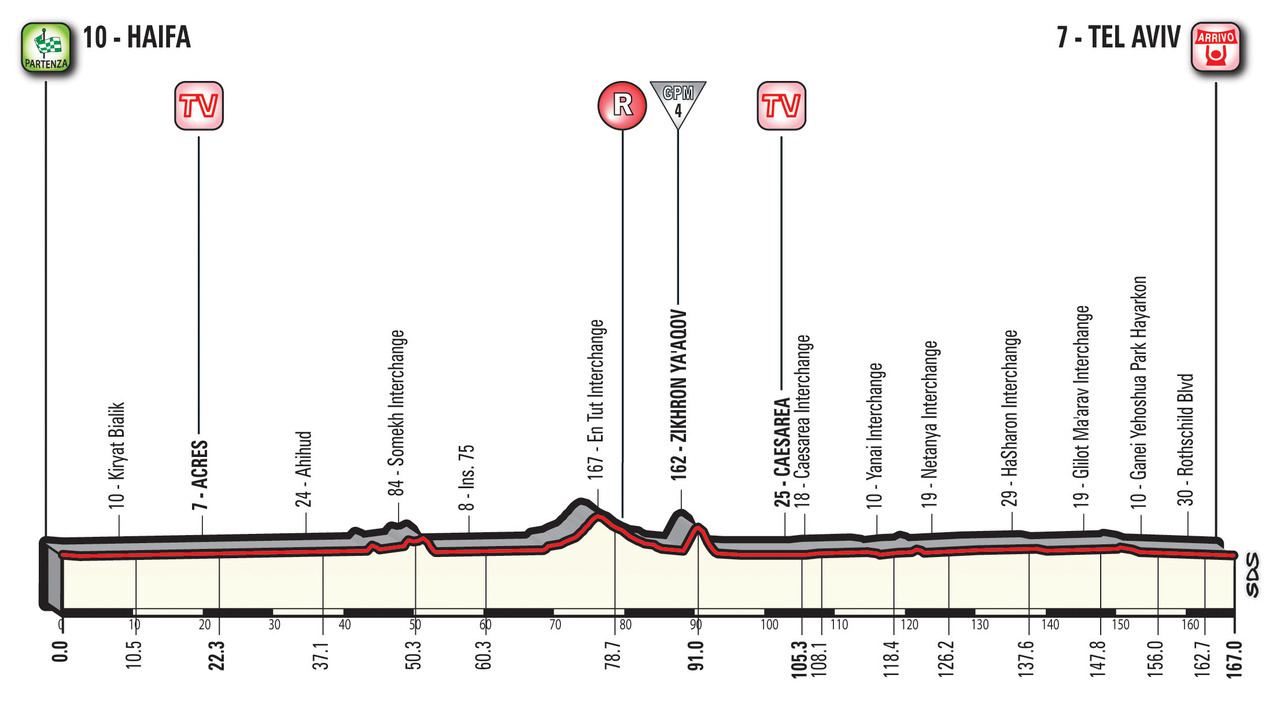 One for the sprinters? It’s flat and here lots of big highways which make the race exposed to any coastal crosswinds and the race passes several windsurfing hotspots. Expect a breakaway to go because the mid-stage climb means the mountains jersey is there for the taking.
One for the sprinters? It’s flat and here lots of big highways which make the race exposed to any coastal crosswinds and the race passes several windsurfing hotspots. Expect a breakaway to go because the mid-stage climb means the mountains jersey is there for the taking.
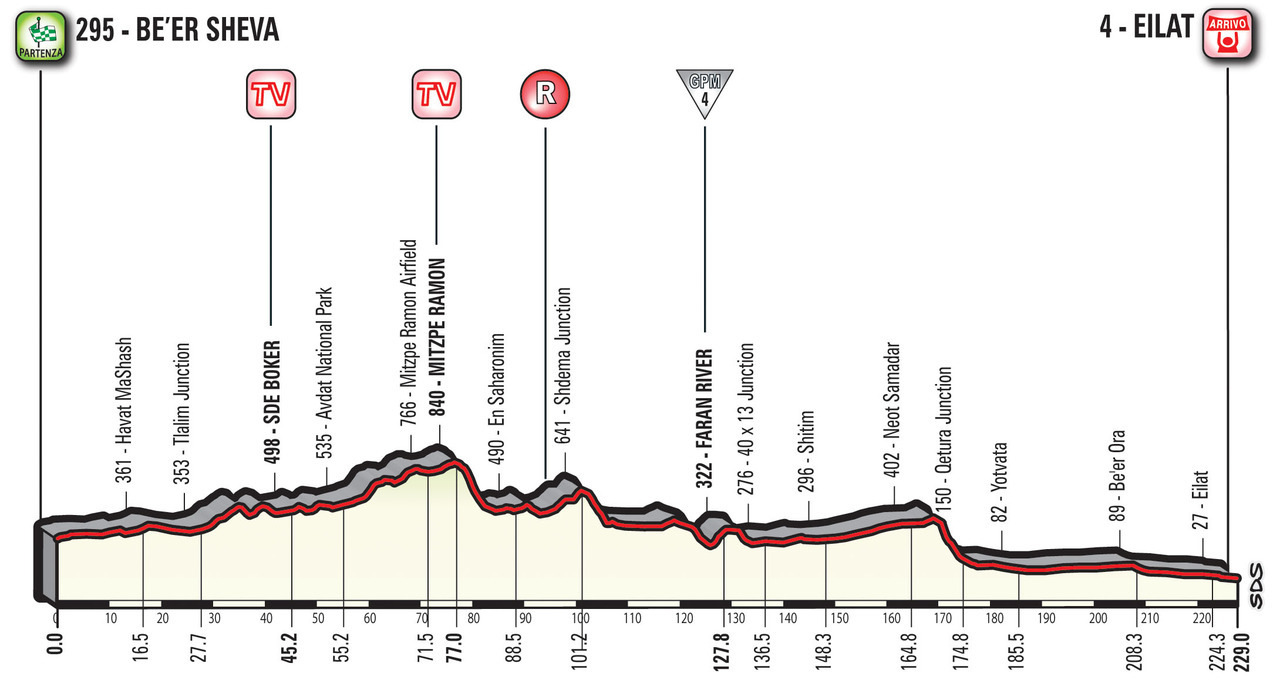 Another one for the sprinters as the peloton crosses the Negev desert. It won’t take 40 days and nights although if the weather is calm time might pass slowly before they finish by the Red Sea in Eilat.
Another one for the sprinters as the peloton crosses the Negev desert. It won’t take 40 days and nights although if the weather is calm time might pass slowly before they finish by the Red Sea in Eilat.
 After a rest day for the riders and travel for the caravan the race returns to Italy and here’s a lively stage that twists around Sicily’s south-east corner, a test for the legs… and arms given the often dilapidated state of the Sicilian roads. The finish is typical of the Giro, of Italy, with a hilltop town featuring a twisting, irregular climb to the finish.
After a rest day for the riders and travel for the caravan the race returns to Italy and here’s a lively stage that twists around Sicily’s south-east corner, a test for the legs… and arms given the often dilapidated state of the Sicilian roads. The finish is typical of the Giro, of Italy, with a hilltop town featuring a twisting, irregular climb to the finish.
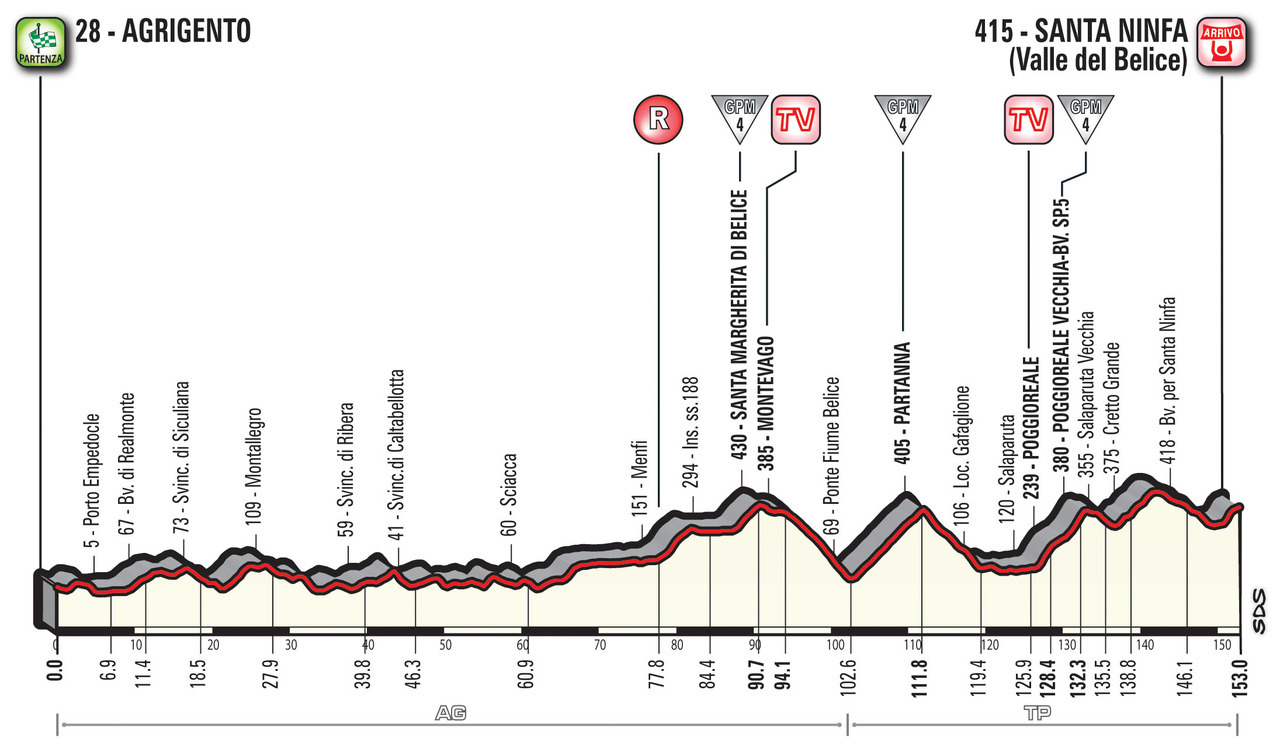
A start in Agrigento as a tribute to Luc Leblanc, winner of the 1994 World Championships here? Probably not but a good stage nonetheless with another lively finish featuring a 12% ramp just before the 1km to go point to ruin the hopes of heavyset sprinters and reward the more versatile riders with the points jersey.
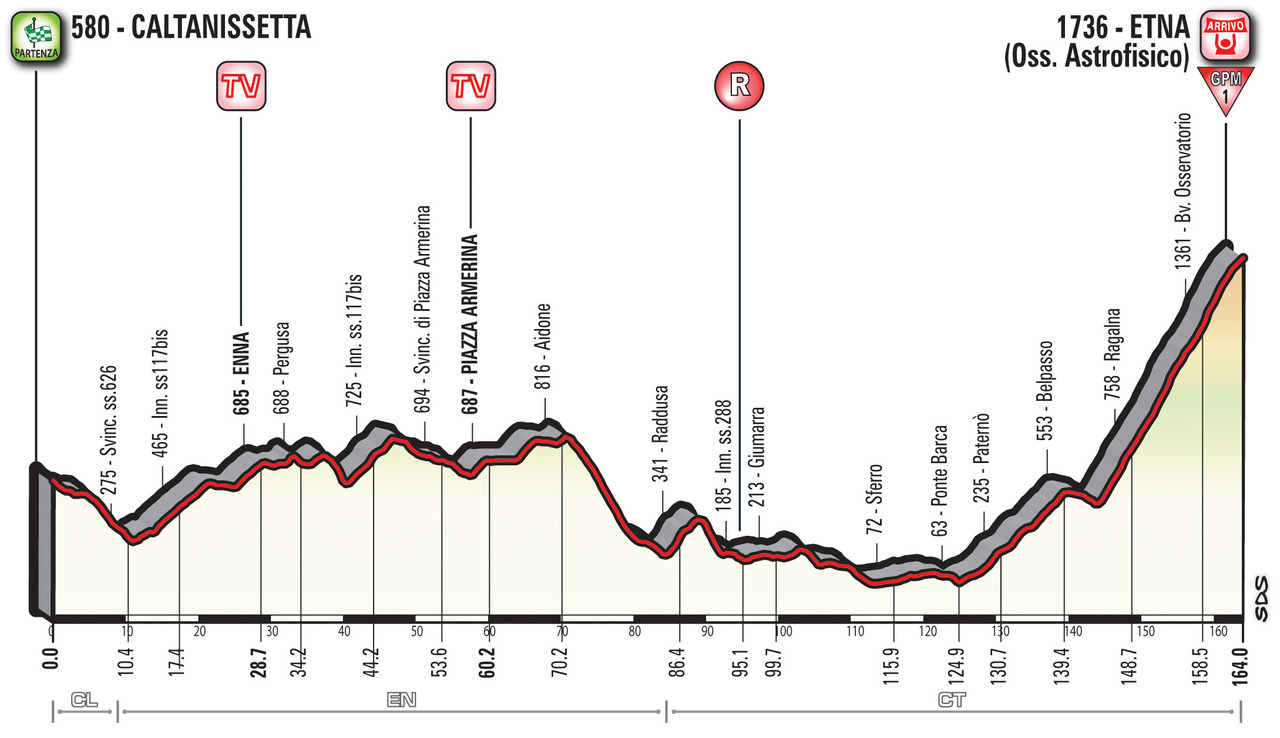
The first summit finish of the Giro appropriately enough on Ascension Day. Last year the race also had its first summit finish atop Etna and you might remember the leaders huddled in echelon formation during the climb. This is a different route up the mountain and a more irregular climb, a few steep sections but plenty of 3-4% moments.
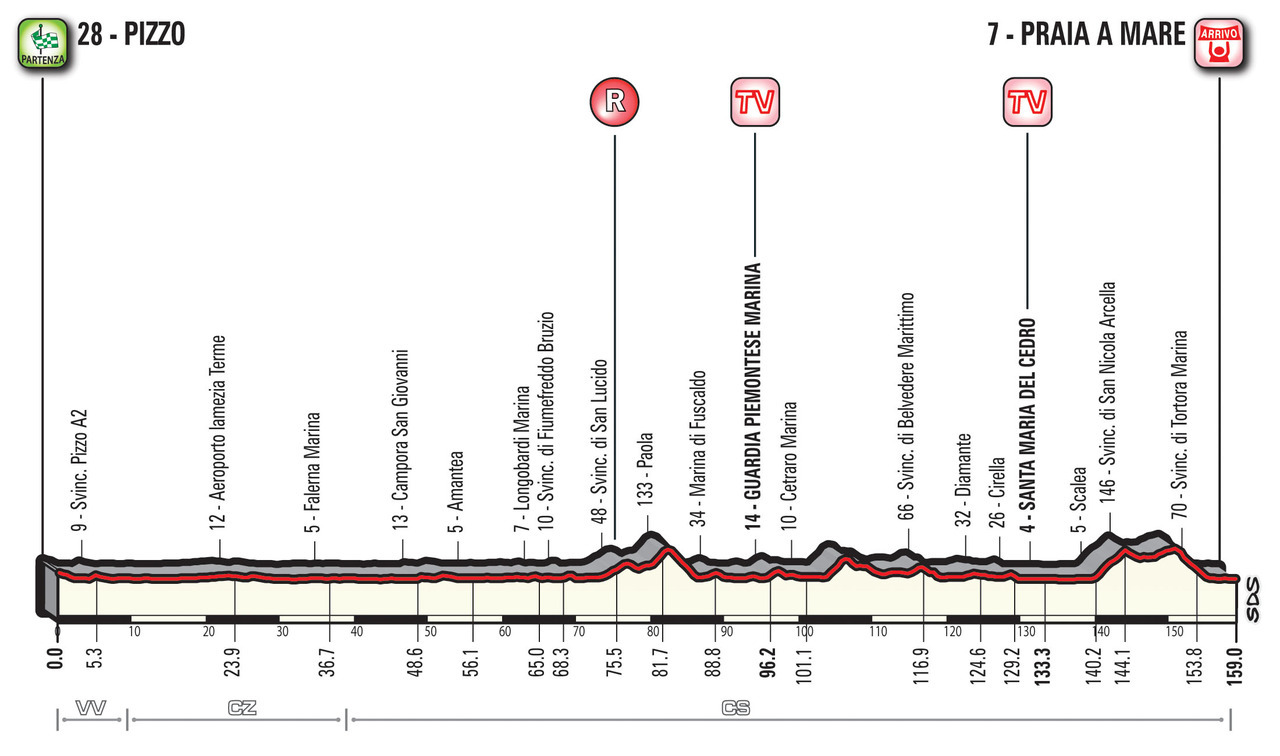
The small bump late on the profile can ruin things for the sprinters. If Praia a Mare is familiar the Giro took a similar route in 2016 but added a much bigger climb 50km from the finish to shake things up.
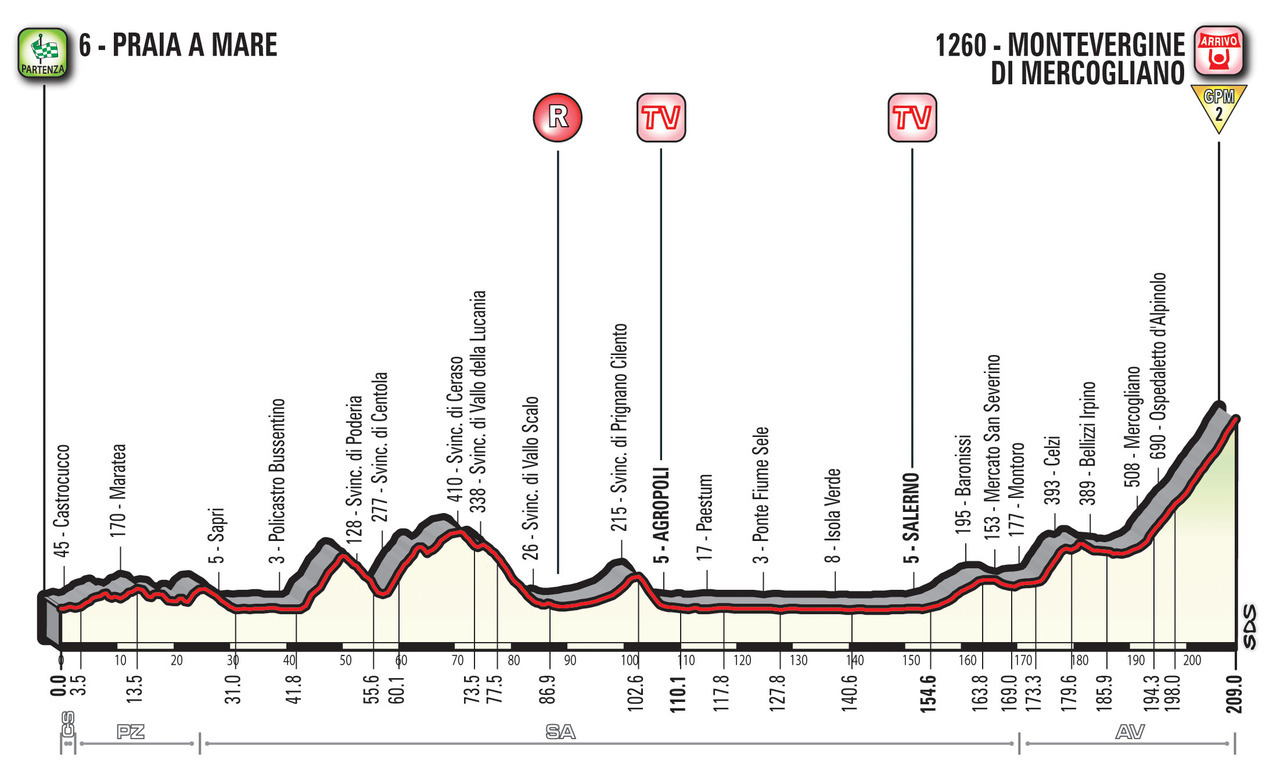
A summit finish but a big ring climb. The Giro came here in 2011 when neo-pro and ex-runner Bart de Clercq soloed away to take a big win… and almost vanished from the results thereafter, excepting a stage win in the Tour of Poland. Otherwise it’s a climb for punchy riders, if he’s in form then Diego Ulissi is the prototype for this sort of finish.
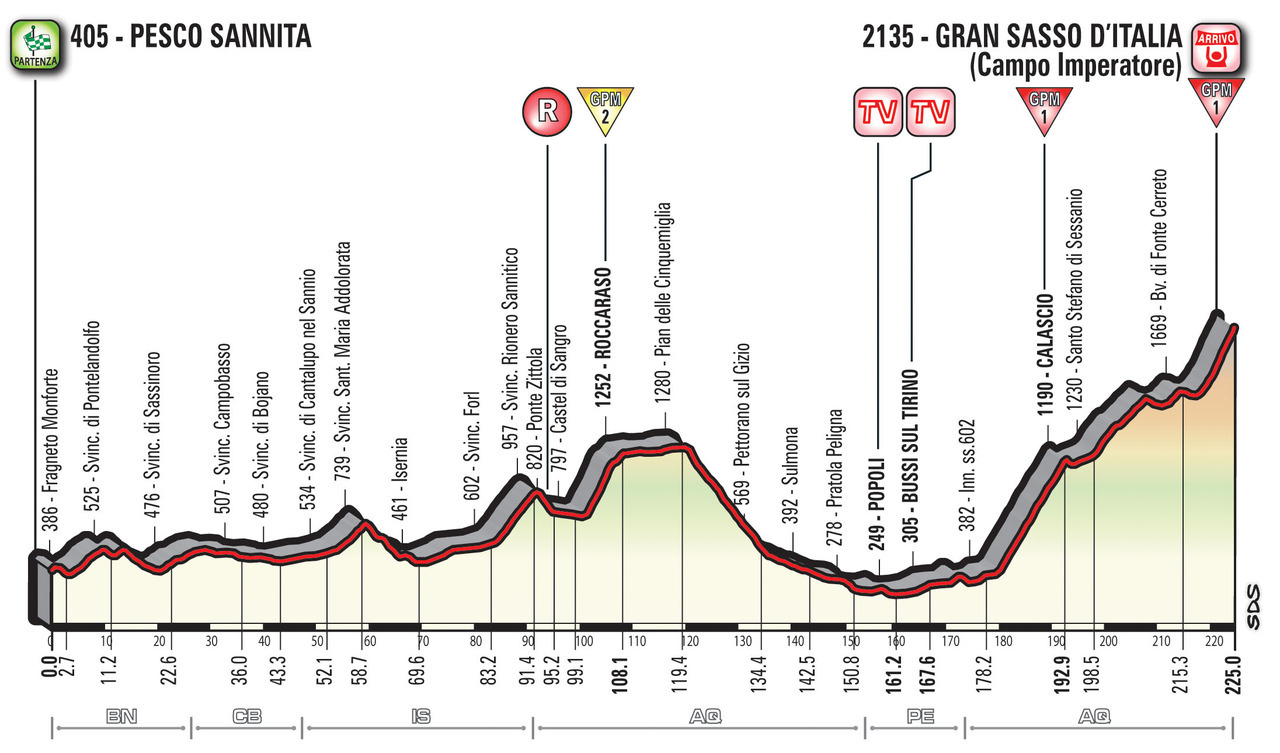
A long day across the Apennines and a battle for the breakaway to stay clear. The final climb up the bluntly-named “Great Rock of Italy” is a famous place in Italy but has been used sparingly by the Giro and this time the race will commemorate Marco Pantani’s 1998 win, the last time the Giro visited. It’s a long climb and often gentle but the final kilometres tighten up and can allow a GC showdown.
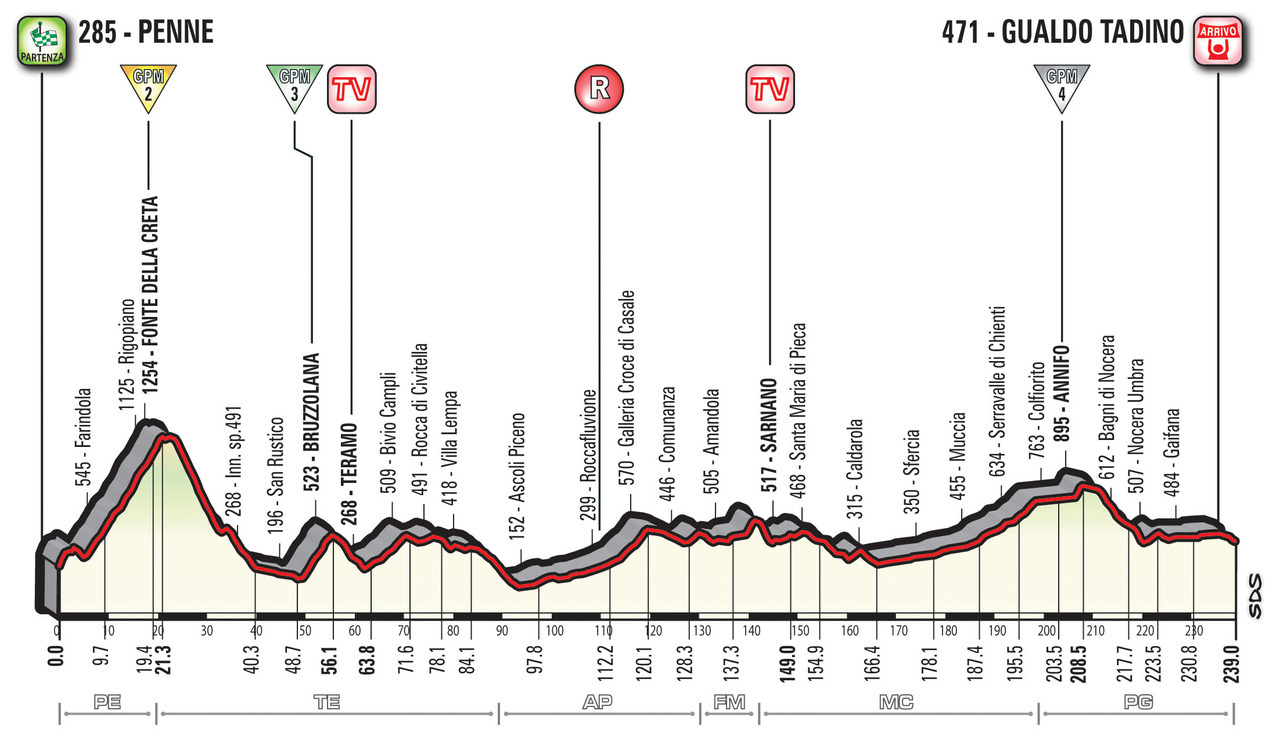 The longest stage of the race, all the breakaway specialists and escape artists will have an eye on this stage and after warming up before the start the opening climb should see a move barge clear.
The longest stage of the race, all the breakaway specialists and escape artists will have an eye on this stage and after warming up before the start the opening climb should see a move barge clear.
 Another stage for the breakaways across familiar roads from Tirreno-Adriatico and via the town of Filottrano, once home to Michele Scarponi before the steep uphill finish in Osimo.
Another stage for the breakaways across familiar roads from Tirreno-Adriatico and via the town of Filottrano, once home to Michele Scarponi before the steep uphill finish in Osimo.
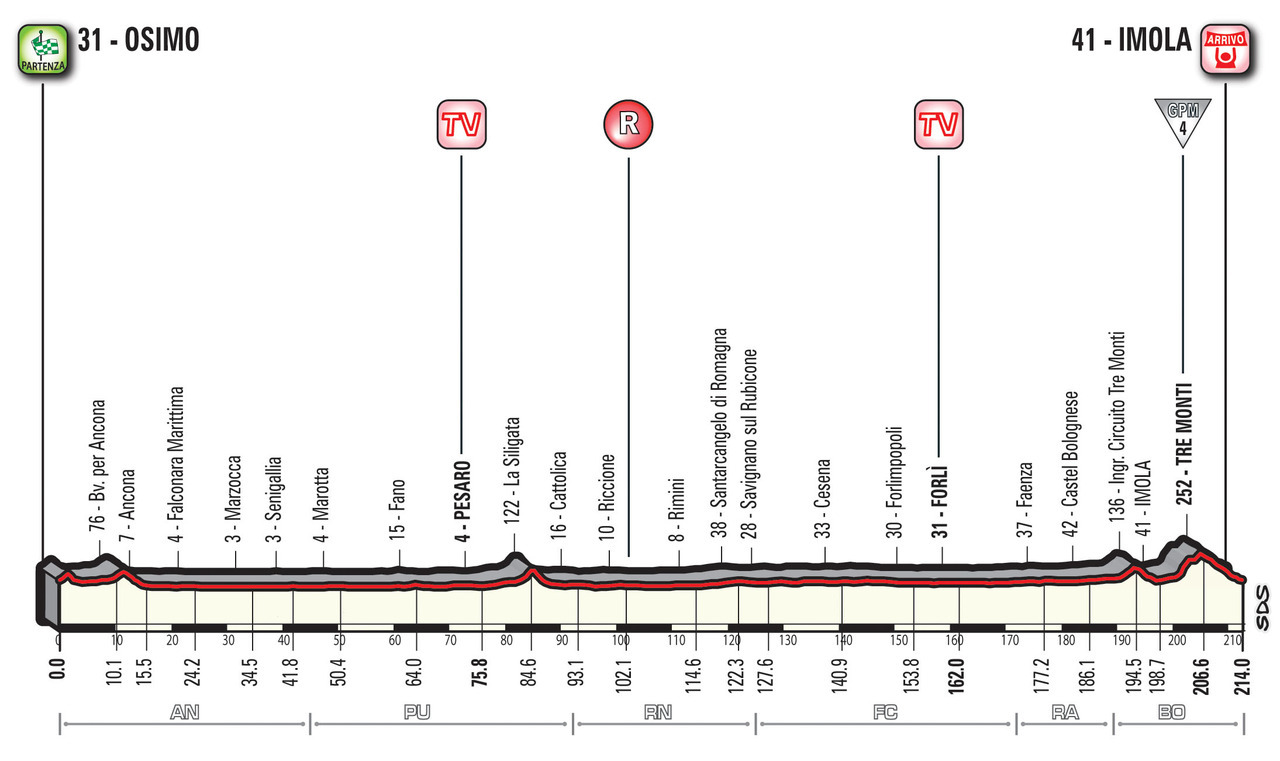 It looks as flat as a piadina but they ride into Imola and take the Tre Monti circuit, used before in the Giro and in host to the 1968 world championships and it’s got 4km at 4% including some early 7-8% to eject a sprinter or two before the finish on the Ferrari motor racing circuit.
It looks as flat as a piadina but they ride into Imola and take the Tre Monti circuit, used before in the Giro and in host to the 1968 world championships and it’s got 4km at 4% including some early 7-8% to eject a sprinter or two before the finish on the Ferrari motor racing circuit.
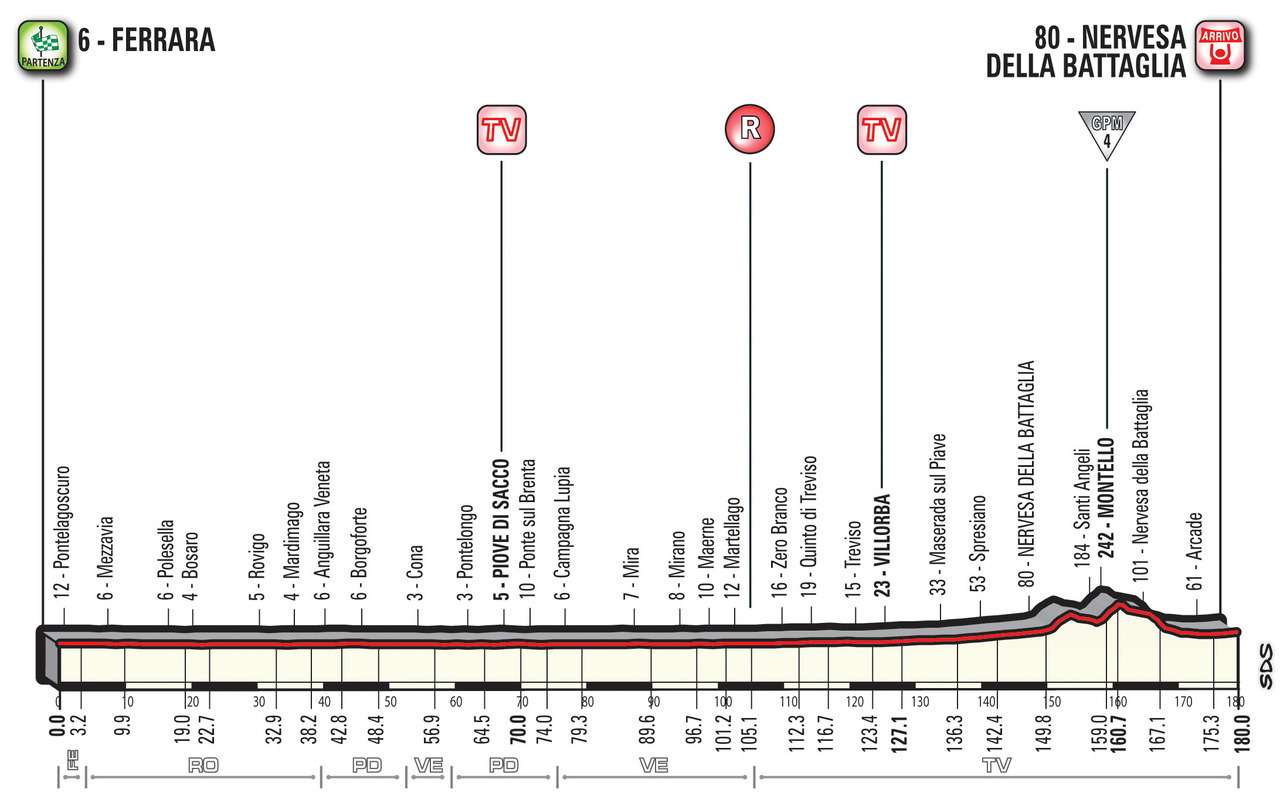 A stage across the pianura, the plains, and a rest day for all but a few sprinters and their helpers, some of whom will have booked flights home after this stage.
A stage across the pianura, the plains, and a rest day for all but a few sprinters and their helpers, some of whom will have booked flights home after this stage.
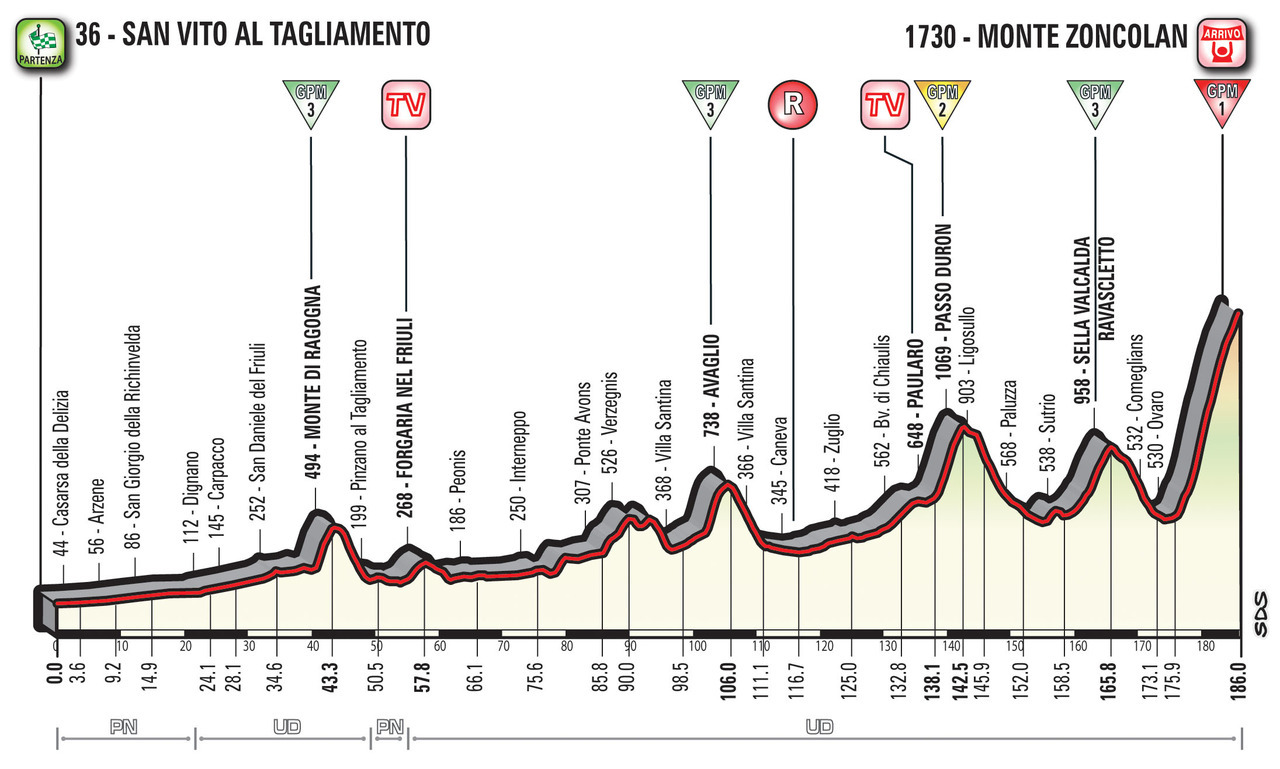 There’s plenty of climbing along the way but this stage is all about the final climb of Monte Zoncolan, a climb so hard it is frequently used a reference point, for example “is it as hard as the Zoncolan” ask people when a goat path of a climb appears on the Vuelta route. It’s a crucial stage for the climbers because if they have other opportunities, several of the upcoming summit finishes are gentler and allow riders to draft behind their team’s mountain trains: here it’s everyone for themselves, a private contest of Watts per kilo. Put simply the likes of Fabio Aru, Esteban Chaves, Miguel Angel Lopez et al need to take time on Tom Dumoulin and Chris Froome.
There’s plenty of climbing along the way but this stage is all about the final climb of Monte Zoncolan, a climb so hard it is frequently used a reference point, for example “is it as hard as the Zoncolan” ask people when a goat path of a climb appears on the Vuelta route. It’s a crucial stage for the climbers because if they have other opportunities, several of the upcoming summit finishes are gentler and allow riders to draft behind their team’s mountain trains: here it’s everyone for themselves, a private contest of Watts per kilo. Put simply the likes of Fabio Aru, Esteban Chaves, Miguel Angel Lopez et al need to take time on Tom Dumoulin and Chris Froome.
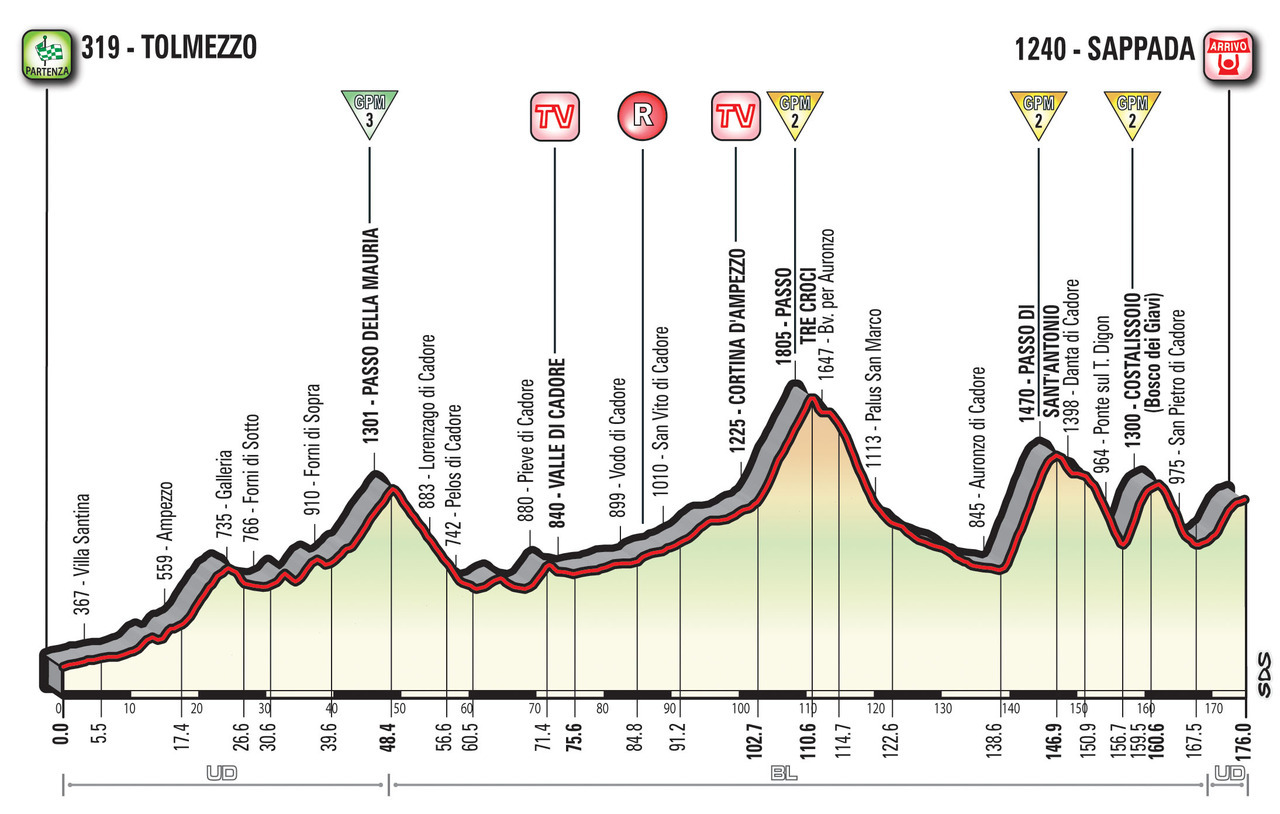
On paper this is the most interesting stage of the Giro. It doesn’t have the high altitude or celebrity climbs but there’s the promise of a roller-coaster finish and all with the dull ache of the Zoncolan from the previous day. But it’s not an ambush if everyone is expecting it and the strong teams will look to control things as much as they can.

A decisive stage, 34.2km might be historically short for a time trial in a grand tour but these days it’s plenty to prise apart the overall classification and pure climbers can lose minutes on a course like this with its flat roads. It’s in the mountains but rather than taking a climb it sticks to the Adige valley road.
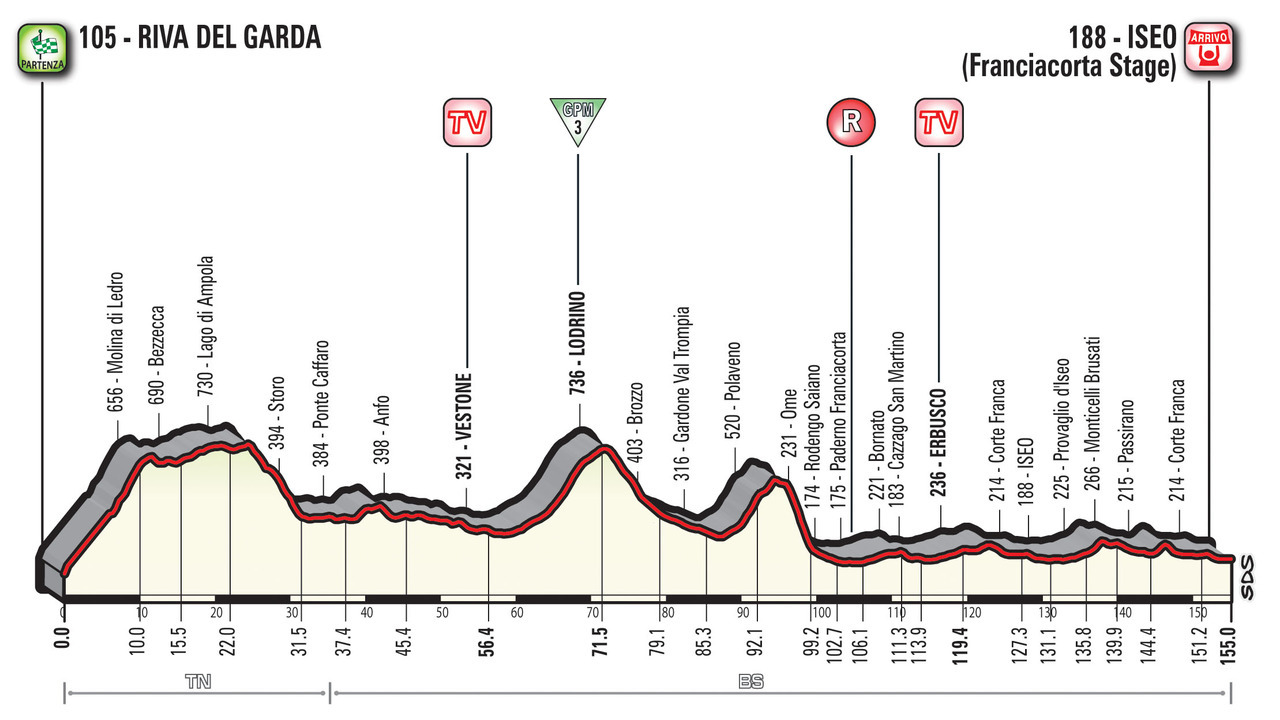 A short stage and a tussle between the breakaway and sprinters teams looks likely. This one is the annual wine stage, presumably to the delight of the press room and caravan, here celebrating the fizzy franciacorta.
A short stage and a tussle between the breakaway and sprinters teams looks likely. This one is the annual wine stage, presumably to the delight of the press room and caravan, here celebrating the fizzy franciacorta.

180km in the big ring past plenty of rice fields, vineyards and increasing numbers of hazlenut plantations to satisfy the limitless demand of the nearby Ferrero HQ and its Nutella spread. Then a brutal change with the climb to Prato Nevoso, last used in the Giro in 2000 but used in the Tour de France in 2008 and as a guide to the slope Denis Menchov crashed on a hairpin bend going uphill that day. It’s a long steady climb but if it’s a ski station the road is narrow at times. The steepest parts come early but it’s the length that should do the damage.
 Arguably the most picturesque stage as the race heads into the Alps and the even slopes but gravel surface of the Colle delle Finestre – this year’s Cima Coppi – which is far from the finish but should still be selective as there’s not much time to recover before the drag up the valley to Sestriere and then the final climb of the Jafferau which is hard going, 7km and most of it over 10%.
Arguably the most picturesque stage as the race heads into the Alps and the even slopes but gravel surface of the Colle delle Finestre – this year’s Cima Coppi – which is far from the finish but should still be selective as there’s not much time to recover before the drag up the valley to Sestriere and then the final climb of the Jafferau which is hard going, 7km and most of it over 10%.
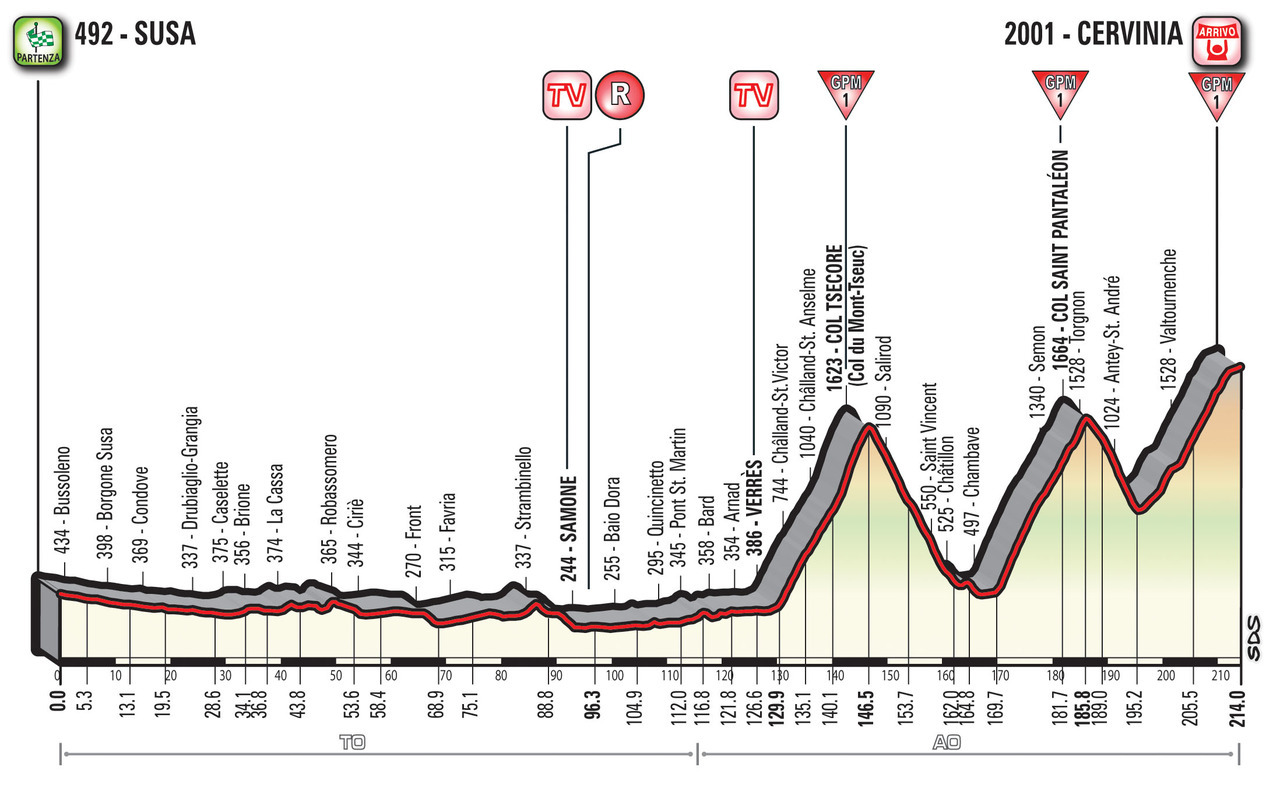 The final chance to turn the tables and the route offers the terrain to upset things. The Tsecore is a hard climb which – records seem hard to find – is being climbed for the first time and after a steady approach up the valley flicks onto a smaller road with sustained sections of 12-14% followed by a twisting descent back down to the Aosta valley and a climb straight away up the Saint Pantaléon, a steady but hard climb before the gradual finish to Cervina, better know to many in Europe and beyond as the Matterhorn.
The final chance to turn the tables and the route offers the terrain to upset things. The Tsecore is a hard climb which – records seem hard to find – is being climbed for the first time and after a steady approach up the valley flicks onto a smaller road with sustained sections of 12-14% followed by a twisting descent back down to the Aosta valley and a climb straight away up the Saint Pantaléon, a steady but hard climb before the gradual finish to Cervina, better know to many in Europe and beyond as the Matterhorn.
 Basta! Whatever you might think about Rome’s mayor she’s brought – should that be bought? – the Giro to the Italian capital, ending the oddity of a grand tour that often sidestepped its capital city. A few laps of Rome await, part urban criterium, part theme park with added cobbles.
Basta! Whatever you might think about Rome’s mayor she’s brought – should that be bought? – the Giro to the Italian capital, ending the oddity of a grand tour that often sidestepped its capital city. A few laps of Rome await, part urban criterium, part theme park with added cobbles.

There are four jerseys in the race: pink, cyclamen, blue and white.
Pink: the most famous, the maglia rosa, it is awarded to the rider with the shortest overall time for all the stages added together. As such, they have covered the course faster than anyone else. It is pink because the race has always been organised by newspaper La Gazzetta Dello Sport which is printed on bright pink paper. It is sponsored by Enel, an energy company.
There are time bonuses available on all the stages except the time trials:
- 10-6-4 seconds for the first three riders respectively on each stage
- 3-2-1 seconds are available for the first three riders at the second of two intermediate “TV” sprints on each of the road stages
Cyclamen: the points competition. Riders pick up points at the intermediate sprints, the traguardi volanti marked as “TV” on the profiles above and at the finish line. The allocation of points depends on the stage in question, they are categorised with the typical sprint stages offering more points in a bid to place the purple-toned jersey on the shoulders of a sprinter who is handy with mental arithmetic. The maglia ciclamino is sponsored by Segafredo Zanetti, a brand of coffee.
- Category A+B stages (Stages 2,3,7,12,13,17 and 21) offer points for the first 15 riders at the finish: 50-35-25-18-14-12-10-8-7-6-5-4-3-2-1. For the TV there are points for the first eight: 20-12-8-6-4-3-2-1
- Category C stages: (Stages 4,5,8,10,11) offer points for the first 10: 25-18-12-8-6-5-4-3-2-1. For the TV there are points for the first five: 10-6-3-2-1
- Category D: (Stages 1,6,9,14,15,16,18,19 and 20) offer points for the first 10: 15-12-9-7-6-5-4-3-2-1. For the TV there are points for the first three: 8-4-1
Blue: the mountains jersey. It is sponsored by Banca Mediolanum, a bank. Points are available on the climbs. There are five categories of climb:
- 13 fourth category climbs: the first three riders crossing the top of the climb win 3-2 and 1 points respectively
- Nine third category climbs: the first four riders over the top get 7-4-2-1 points
- Nine second category climbs: first six riders get 15-8-6-4-2-1 points
- Eight first category climbs: the first eight riders get 35-18-12-9-6-4-2-1 points
- CC or Cima Coppi: a special award, the “Coppi Summit” for the highest point of the race. This year it is the Finestre on Stage 19. The first nine win 45-30-20-14-10-6-4-2-1 points
White: for the best young rider, this is awarded on the same basis as the pink jersey, except the rider must be born after 1 January 1993, ie aged 25 or under. It is sponsored by Euro Spin, a discount supermarket.
Obviously a rider can’t wear two jerseys at once, they’d get too hot. So if a rider leads several classifications, they take the most prestigious jersey for themselves and the number two ranked rider in the other competition gets to wear the other jersey. For example if a rider has both the pink jersey and the blue mountains jersey they’ll wear pink whilst whoever is second in the mountains jersey will sport blue jersey. In case you’re wondering the official hierarchy is pink > points > mountains > white.
There are also a host of daily prizes which keep the podium ceremonies going for some time like the Super Team, Fighting Spirit, Fairplay, Breakaway and more.
The unmissable stages
Anything can happen during the Giro but there are some stages that matter more than others.
- Stage 6 – Thursday 10 May: the Etna summit finish
- Stage 9 – Sunday 13 May: the Gran Sasso d’Italia
- Stage 14 – Saturday 19 May: Monte Zoncolan
- Stage 15 – Sunday 20 May: the Sappada mountain stage
- Stage 16 – Tuesday 21 May: maybe not gripping but the TT will be decisive
- Stage 18 – Thursday 24 May: the Prato Nevoso summit finish
- Stage 19 – Friday 25 May: the Finestre and Jafferau
- Stage 20 – Saturday 26 May: the final mountain stage
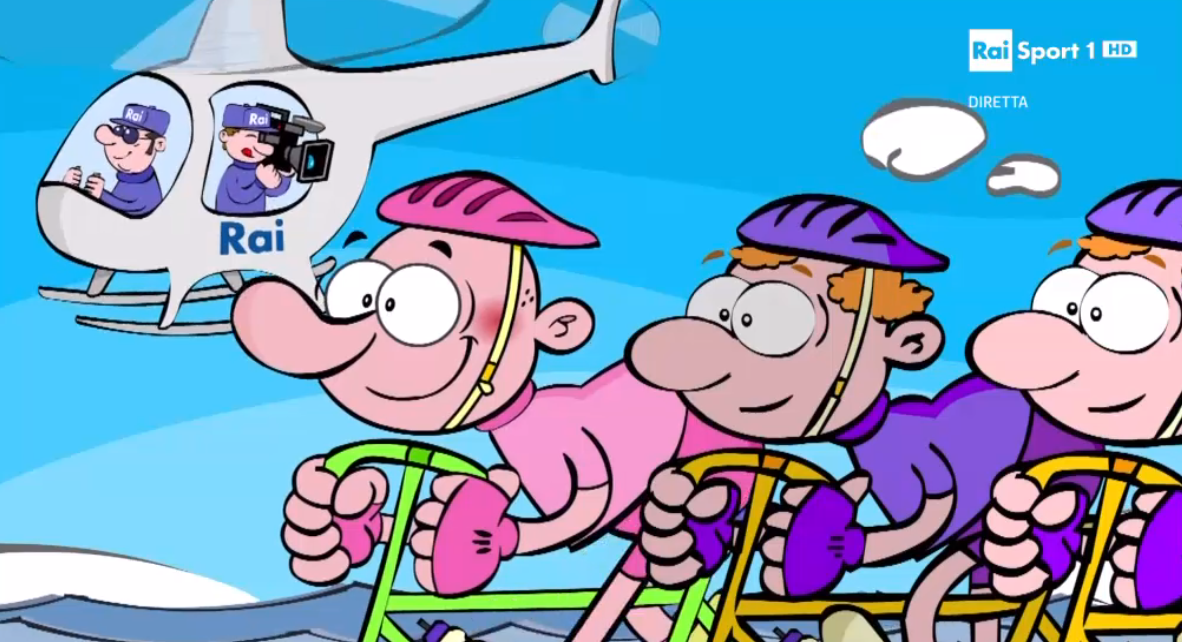
TV viewing
Eurosport is covering the race across most of Europe plus Australia and New Zealand. It’s on L’Equipe TV in France and streaming via Fubo in the US and Dazn in Japan.
Italian host broadcaster RAI offers the best coverage with experienced commentators as well as roving reporters on motorbikes to add extra coverage, it’s on TV and radio in Italy with the geo-restricted website RAI.it.
As ever cyclingfans.com and steephill.tv are the go-to sites for schedules and pirata feeds. The timing varies but as a rule the live coverage begins at 2.45pm CET and the finish is expected for around 5.15pm CET each day.
Click or save the ics / iCal / iCalendar file and you can import it into your electronic diary. One or two clicks and it’s on your iPhone / Outlook etc.

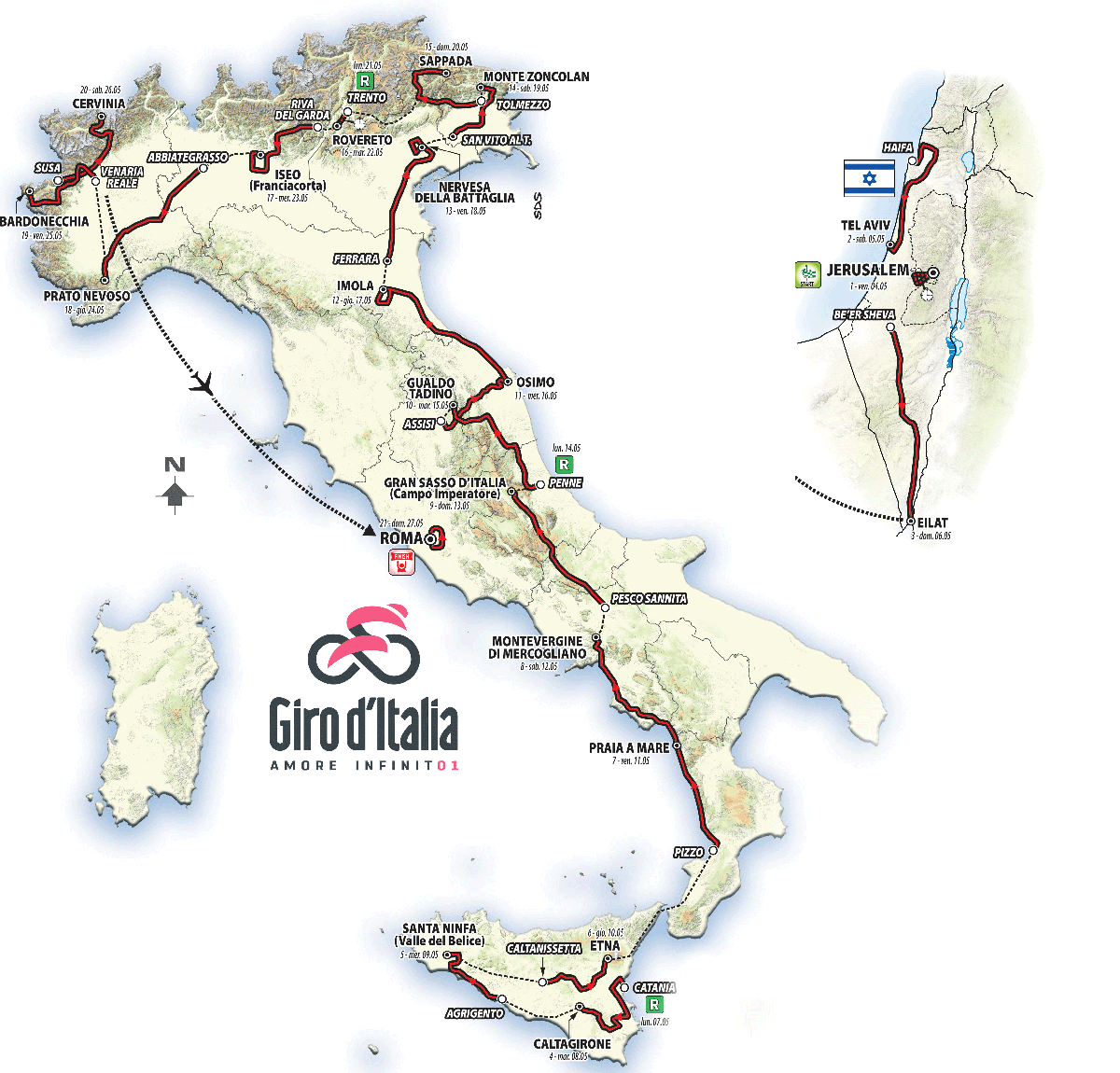
“….often dilapidated state of the Sicilian roads.” makes me wonder when you were last down here?
I’d agre that pretty much all of the roads in Italy have suffered since the economic crisis but I’m not so sure Sicily’s roads are all that much more dilapidated than other places. I rode in Belgium last week and was rather surprised at the poor state of the pavement on a lot of the L-B-L course
When you cross the border from The Netherlands to Belgium it is often quite noticeable in the state of the road surface. I remember stopping my car once on the highway shoulder because I thought I had a flat, it was just the road being very bumpy. A little further down the road I saw another Dutchman doing the same. When I was in Sicily (without a bike) two years ago the drivers where a much bigger concern to me than the quality of the pavement!
It was notable last year with all the cracks, holes, etc, I saw it myself, especially on the stage around Etna to Messina. The peloton had a lot to say about it too, not all vocal bu there were some public comments about it, here’s Rory Sutherland saying “the roads yesterday where terrible, they were really bad in Sicily” https://www.youtube.com/watch?v=Fq73-dzAev4 It tends to vary by region.
I cycled in a few regions in Italy and I second that the road surface is equally bad in most of them, which is a terrible shame. Lombardy and Alto Adige/Trento are mostly ok but for the rest of the regions I had visited I saw roads with cracks, potholes, uneven segments, which makes your hands, feet and seat really hurt after several hours in the saddle. It was not only the case for Sicily but surprisingly also for the hotbed of Italian cycling – Tuscany. It obviously varies from road to road but the Strada Provinciales leave a lot to be desired.
I can recall this time last year us all doing an exercise on the possible TT time losses of Quintana on Dumoulin.
It looks to be a similar picture again but the chief point of interest, for me at least, is how much time Froome may lose to Tommy D on the chronos?
Dumoulin was on such staggeringly good form at Bergen that he surely has to start as the top TT’er between the pair.
If he were to put 1″ / km into Froome on the TTs, that could equate to a 44″ advantage both.
Anything more than that, and it starts to look a very big gap – even for Froome and his Sky team.
Do we see Dumoulin losing anything more than a minute on this year’s course outwith the TTs, given the numerous ‘power climbs’ that have been pointed out?
I’m thinking Dumoulin could be a very tough tulip to crack here….?
There will be a piece about the contenders later this week but as you say if he’s got that kind of form… but note he’d trained specially for the worlds whereas Froome had done the Tour-Vuelta and was running out of steam by Bergen.
Dumoulin himself said he never felt as good in his life as he did in Bergen, so that will be hard to match. He tailored his program again to the Giro this year and seems to be on the right track but truly good form cannot be dished up on command. Froome’s form is much more of a question mark, especially with the salbutamol case looming. If he knows he’s only buying time and the result will probably be scrapped can he be motivated enough? It didn’t stop Contador back in the steak days. It will also be a question whether or not he can shake Tom off in the mountains. Sunweb’s team seems a bit better tailored to a GC bid than last year and surely TD has trained for climbing, but still Froome has been the better climber historically. And then there is Lopez, Aru , Yates, Chaves, Pinot et al that will need to take time in the mountains so that will stir things up.
I don’t think we will see a vintage Froome at the Giro. We will get something ‘sub-par’ and then we won’t be talking about him for very long. He doesn’t need the spotlight at this moment and winning is not really going to help him, especially if it’s all going to be stripped away for a doping ban.
Surely if Froome is sub-par this year that will be seen by many as ‘proof’ of his doping?
Of course, it would prove no such thing: whatever he has been doing in previous years he is very likely to continue to do this year (he wasn’t caught previously – if doing anything against the rules – so why stop?). Many seem to be citing his lack of form this year, but look at his form early last year.
I doubt he’d turn up sub-par and I expect him to win the race.
Yours is a very dubious argument. Froome was apparently yesterday’s news less than a year ago last June when he failed to podium at the Dauphine, a race he’s won three times. The doomsayers then had it that Froome (who then had zero wins in 2017) would lose the Tour and disappear into obscurity. He answered them by being one of very few to ever win two grand tours back to back (subject to a pending AAF, of course). Regardless of his subsequent problems, this shows that Froome was far from done only 8-9 months ago. This, of course, doesn’t mean he can be the same in 2018 and the history books show that all the greats had great achievements before they suddenly found they couldn’t do it anymore. For example, the likes of Merckx, Hinault, Anquetil and Contador won back to back grand tours before then, suddenly, never winning another again. So Froome will come to the cliff edge of his ability and then, suddenly, drop off. I don’t think that is far away but I wonder of 2018 is the year or not. Time will tell but three in a row is one hell of a motivation.
The last thing I expect is for Froome to purposefully fly under the radar to avoid suspicion. He’s entered so that he can hold all three GT’s at once and have a crack at doing the Giro-Tour double, not just to fulfil some contract. Its worth baring in mind though the sudden drop off that can befall dominant GC men when they reach a certain age as RonDe has mentioned and also that Froome will be attempting his 3rd Grand Tour on the bounce aiming for the win. Attempting the same thing seemed to have a disastrous affect on Quintana. By the Tour he’ll be on his 4th! If Froome doesn’t win they are likely to be the reasons why, aside from any random bad luck that might occur.
Let me say that last year I and others on this blog were seeing as a possibility that Froome could be just shifting his prep during the first part of the year in order to face the double GT challenge – even before the TdF even started.
What’s happening this year is just consistent with what we saw before. Any decline in performance would be motivated by different reasons, as RonDe and Richard S pointed out (although I don’t believe in RonDe’s theory of the sudden cliff, especially watching a little more closely the suggested examples – but I won’t delve into the subject, which I tackled before).
Froome didn’t look at all inclined to low profile while managing this whole story…
if Froome does fall off a cliff I wonder if it would be the same one he miraculously flew up in 2011
I wonder why the finishes are mostly uphill/mountain top/summit vs a tough climb then a downhill. The descent to the finish are especially hazardous I guess?
Parcours was designed to attract Froome, hence the preponderance of monoclimbs and lack of stages with multiple big climbs. This, the presence of Froome and the start in apartheid Israel have resulted in me being less enthusiastic about a Giro than I’ve ever been.
I suspect you can find reasons to be pessimistic about a lot of things. I’m not overjoyed about the Giro being used for the Israel propaganda machine myself but I have no problems with the parcours. In fact, I think it brings Superman Lopez very much into the fight, especially when Astana look to have the strongest team on paper.
Many have this as Dumoulin vs Froome. But I’m not so sure.
Even if the course was designed for Froome (and it was – just like last year), you’re absolutely right when you say that there are other riders who share his technical profile, at least when climbing is concerned, and who could appreciate monoclimbs.
I’m not sure if Superman López will be limited to monoclimbs in the long term (he’s a daring rider who often tried to go from far), but for sure now they look one of his specialties, which means that, no doubt, they favour him someway. Absolutely so. Yet, I’d add that he probably lacks some of the due experience as a three weeks contender.
Aru’s changed his U23 style to adapt to Froome-like racing approach when climbs are concerned. Several of his most brilliant performances as a pro came on monoclimbs.
However, I think that people consider that these riders’ limits in ITTs will be difficult to overcome. Which is just fair, and would normally place them well behind as TdF contenders, but they’d have had a fair chance at the Giro, which is availabe to a wider range of phyisical types. Hardly this year.
Astana has been on fire in terms of stage wins, but that doesn’t mean they’ll be as competitive for GC. It’s a different kind of work. And they didn’t exactly show great prowess in that sense at the last Trentino (remember López wasting his chances to set up something for Luisle?). Great line up, anyway, even if I’m not sure they’re better than Sky, which sent in a royal court for Froome. But not a huge difference in level, all in all.
Orica also brought a good team, but at least several of them (not just the captains) would prefer a more testing course in terms of resistance. Same for FDJ – just a bit less strong.
On a very different level – Bora’s Austrian section will also be interesting, just as the Anglo trio of Woods, Dombrowski (will he ever be back?) and Carthy at EF.
The ITT is the only reason I don’t think Lopez will win the race gabriele but I think he could win multiple mountain stages and should Dumoulin and/or Froome crack on one of them due to their extra kilos compared to Lopez then he could make one or two decent gains (30 secs plus) He will be cheered that stages 18/19/20 are three good stages for him and he should try to maximize his gains on the Zoncolan too where it really is man against the gradient.
Geez, again I have to agree with RonDe.
Where we no doubt differ is my wish for the sporting gods to do what UCI, CAS, etc. have (so far) failed to do. SKY’s had rotten luck at the Corsa Rosa up to this point and that might be all that stands to prevent another travesty like the Contador fiasco. Back then I suggested they take maglia rosa and trofeo senza fine photos with whoever finishes 2nd if Contador “won”…same advice this time if Mr. Salbutamol “wins”.
As an unabashed Italo-phile nobody will be surprised with FORZA ARU from me. W Il GIRO!
I trust that the Roman cycling fans are more welcoming than some of their s***bag football supporters.
No cycling fan is or should be similar to any football supporter. Ever. Wherever.
As a general rule with its due exceptions, obviously.
On the one hand, there’s a sport where, in many countries, you need to be previously IDd even in order to *buy* access to the grandstand, then you’re searched before entering the stadium and, finally, you can’t get even close to the action or players.
OTOH, well…
The peculiar nature of cycling’s public – both in itself and as long as watching conditions are concerned – has survived bitter rivalries, which in Italy could be as bitter as any football-related one; political protest; extreme drunkenness; jackets; sheer stupidity in variable dosis. It’s now facing some of its hardest challenges ever with the smartphone & social media era, but long may it live its spirit nonetheless.
Liverpool’s fans’ reputation is not exactly untarnished by history.
Froome’s taken quite some time in other GT’s with downhill finish attacks so that doesn’t quite explain the lack of valley finishes.
Froome is a good descender: what I meant is that it has been seen that he and his team do particularly well when there is one climb at the end of a relatively easy stage. He’s relatively untested over multiple mountains stages as the TdF has had so few of these in recent years. Sky have shown some tactical failings in the past. I’m not going to pretend that I’m not biased against Sky/Froome, but these simplistic stages with one climb at the end tend to preclude innovative tactics – that’s why I find them less interesting.
None of the other things I mentioned are Froome’s fault: he didn’t choose the parcours or where the race would start, plus the rules allow him to ride, so he has every right to ride: it’s the rules that need to change.
But the shadows of the things I mention cannot be ignored.
Froome’s final result might not stand and even if it does many will not accept it.
Infinitely more importantly, and just to give one short example, fourteen Palestinian boys and girls under the age of 18 were shot dead by Israeli forces in the West Bank and Gaza Strip during 2017.
I – and I’m sure others – could have ethical objections about almost any country a bike race was held in, but you have to draw the line somewhere and for me Israel’s up there with the likes of Saudi Arabia. And I don’t think we should just ignore the politics and focus on the cycling.
Mate, mate… what ya bangin’ on about? I got 3 stages with multiple climbs (15, 19 & 20) vs 5 ending with a single banger, but one of thems the Zoncolan innit? Not chalking that up to Froome so makes it 4 – 4 for mine.
Not willing to enter the whole debate above (not enough time), but stage 15 isn’t a serious mountain stage. It’s a great hilly or “mezza montagna” stage, it’s promising (even if it’s too obvious a call), I’d love to have more of that – but, come on, two 2nd category climbs and a long false-flat drag in the last 65 kms make a *mountain* stage? The total kms of *climbing* in the last 120 kms is… some 20 kms, split in shorter sections, most of them concentrated in the Tre Croci, far from the line.
The Zoncolan stage has got some more climbs before the finish, but there’s a total lack of proportion between their difficulty (and duration) and the final one, which makes it pretty much of a monoclimb in tactical terms. And, for instance, it doesn’t even make sense to launch any teammate on the front thanks to the previous climbs, because on the Zoncolan their collaboration won’t matter much. I think that if RCS ever needs to include a literally monoclimb stage, the Zoncolan could be the right one, unlike Prato Nevoso or Gran Sasso which end up making very little – tactical – sense (however, having only a lonely Zoncolan would make for a less significant stage, which is what RCS also wants to avoid in order to protect the mythical status of the climb, hence the need to increase the overall difficulty of the stage, although it doesn’t add tactical options).
I hope I’ll be proven dead wrong, of course.
I can’t see why the Zoncolan should necessarily be that bad for Froome. It’s an uphill TT, something Froome’s good at. It’s a pure W/kg show, and Froome’s again among the best under that respect. Of course, the pure weight component becomes more important, which might not be great for Froome, and the train might be less useful except for pace-making (not that bad, either) – yet, historically several “heavier” riders put in good performances there, precisely because of the factors I highlighted above – and often one of those was enough for them, not even needing both: Bruseghin, Poels, Mazzoleni, Basso, Rolland, Andy Schleck et al.
Sure, the last couple of stages is quite good, and they’re (finally!) part of three more or less hard days, something we really missed last year. *But* if the Giro will already look sealed, it will be easier to control them. Anyway, they’re good.
Until then, you don’t have many options to go creative with aggressive teamwork and middle range attacks, maybe the first two Sicilian stages could work, but will anyone dare to take risks there? Astana 2015 did, but they were thinking about killing Contador for the Tour. Will they be equally motivated? Or somebody else?
And, like Sappada, we’re speaking again of hilly stages, not mountain ones.
Just compare the 2016 or 2015 Giro with this and you’ll understand why people feel that there’s a clear (and disappointing) monoclimb shift. Just as last year we had a brutal lack of occasions for “fondo” climbers.
Fair, fair. Froome-dog has put the Zoncolan as his least favorite climb anywhere. Interesting.
@Really Euro
Re: Froome and Zoncolan (comments are going a little astray, and I’m speaking about their position not necessarily about their content ^__^)
Well, once I was visiting a friend far from home and I went riding with a bike he lent me. We had little time and so I didn’t care much about setting up saddle height to the last couple of cms. The consequence is that I went out pedalling with a low saddle; when I was sitting I couldn’t get the appropriate leg stretch, the knee yet too bent at max push. We were climbing a 5% not too long hill, but I can grant you that it became my least favourite climb ever.
Now.
Let’s watch again that video where Froome is riding up Zoncolan… ^__^
(PS1 Yes, I know, marginal gains, and a low saddle will soon become the new 100 RPM *LA trademark*, and a peculiar biology, and think out of the box, change the old – bike-setting – rules, they’ve done their homework and so on… whatever, but it really hurts to watch him pedalling like that! More than ever – and it always hurt quite much)
(PS2 He apparently made a very decent time, for a relaxed test ride, and despite the saddle height! I’m starting to suspect that he hung on the e-bike guy)
Got myself a trip riding the Dolomites, the Zoncolan (34 x 32!) and Slovenia this fall so’ll be all over that stage. And the mans not always great when it pushes 20%… Peyragudes and that Vuelta goat track last year.
Nice trip! Needless to say anything about the Dolomites, but the Friaul, Carnic and Julian Alps on the Austrian, Italian and Slovenian border are simply stunning and offer some great and very challenging riding. The Zoncolan obviously stands out with its 6 km segment from Liariis averaging 15%, but there are more, equally difficult climbs like Altopiano di Montasio, Passo Cason di Lanza and Monte Crostis with some gravel parts. Don’t miss the Vrsic and Mangart in Slovenia, you can make a nice loop containing them and if you start in Austria you can add the Wurzenpass, which has a terribly steep ramp too!
“Froome’s final result might not stand and even if it does many will not accept it.”
Nothing new there then.
I would hope the references such as to ‘apartheid’ in relation to Israel could stop here and not continue for the next week. They can appear, at best, ill informed. If strong views are held about Israel or the Jewish people, I’m sure there are alternative sites that could be found to discuss them.
wouldn’t that be lovely… if we could all just ignore the nasty stuff… except that it just encourages the next promoter to flog his event off to the next dodgy regime for a pot of cash, ‘cos the target audience just want to see a good show…
I agree. This race is being used to help normalise the public perception of Israel as the treatment of Palestinians and destruction of their land and any autonomous future is progressively ignored in the west. We shouldn’t ignore it.
Spot on, Noel.
Disappointing to read today that,c after significant protest about the use of the race for normalisation, the organiser had said they ” “hope that it is treated as a sports event.”
If it was just going to be treated as a sporting event, it wouldn’t be worth a fraction of the reported £10m RCS have pocketed to provide distraction cover for the hosts would it? E.g. the Belfast start which brought in less than half this amount. Talk about trying to have your cake and eat it.
Criticise Israel on cyclingnews and not only do they delete your comments, you get banned from commenting.
The pettiness is amusing, but this is what despotic regimes rely on – and it’s what Israel has always relied on – the silencing of critics.
And the media are going along with it, it seems.
Say one bad word about Israel and someone will claim you’re being ‘anti-Semitic’.
The race is being held in Israel and its being held in Israel because they have things to hide with PR stunts like this. I, for one, won’t be shutting up about it. Look how nuts they went when a Giro map said “West Jerusalem”!
Heartfelt +1
+1
This race race won’t feel right for me until Tuesday 8 May.
“If strong views are held about Israel or the Jewish people”.
What sort of sentence is this?
Mixing up two hugely different and sometimes barely compatible if not opposite kinds of persons: those who hold “strong views” about Israel or those who may do the same about… the Jewish people.
Israel as a State has deserved international, official reprobation despite the blind support they usually receive by the USA, with the obvious diplomatic consequences. They, as a State, don’t respect international rulings.
Those are facts, not some secret anti-Jewish plot.
The State of Israel is currently responsible of collective, asymmetric, unnecessary butchery, as many State in human history were, and as the rest of that infamous company, they deserve the harshest condemnation because of that. As a State.
By the way, the “Jewish people” suffer part of the consequences, and those are serious enough, albeit not the worst around. It’s not pure chance if “strong views” about Israel, and not exactly the most flattering, are common even among people who belong to the “Jewish people”.
I, for one, will boycott the first Giro stages. Not because I think it will have any relevant effect, but because I wouldn’t feel at ease, just as I wouldn’t if I had to cheer about Argentina’s 1978 Worlds or the likes.
Thanks for saving me the effort, gabriele – I too will be boycotting the early stages.
Very positive to see others on this blog decrying – and not ignoring – the problems of the Giro being in Israel.
+1. Even though it´s hardly a boycott I too wont be watching the three first stages.
I agree completely! Gabriele is spot on here. Luckily we have the irresistible Tour de Yorks to keep us entertained while we wait. Couldn’t be better timing.
Indeed! Anyway, it was probably going to be the most interesting race, those days – at least in terms of course. It usually had at least one great stage, this year maybe we’ll get a couple of them – and there’s always a decent field of sprinters for the flattest ones.
I love its @UKcyclingexpert style nomenclature, starting with the Tour *de* Yorkshire brand itself, obviously. And, yes, facing the #West# Jerusalem ITT is a tough ask, but it can be done if on the same day you can offer an uphill finish on the *Côte de* Cow and Calf. Pure pidgin! And the finish line is right beside the Cow and Calf “vintage inn and pub”.
Some very interesting youngster to keep an eye on, and a some stars who will trade blows in Classics style stages to bring the GC home.
“[Fill in the blank] as a State has deserved international, official reprobation despite the blind support they usually receive by the USA, with the obvious diplomatic consequences. They, as a State, don’t respect international rulings….”
Seems we could fill in the blank with many States that have/will have hosted many international athletic events. Hard to say Israel is the worst of the bunch meriting exceptional condemnation.
Since I and my country are not without sin, I will be watching.
@TDog
Are you sure there are that many? Try to actually fill that blank. I won’t even call you out about the rest of my post. Nor will I detail how serious is Israel’s situations if we speak of, say, nuclear weapons (to be matched with today’s news about Netanyahu’s timely powerpoints) – I’ll just suggest you to check this list:
https://en.wikipedia.org/wiki/List_of_United_Nations_resolutions_concerning_Israel
PS I promise to try and keep the OT (?) as limited as possible.
Russia – Olympics and World Cup
China – Olympics
People can tune in or out as they wish. I suspect nobody is coming to the comments of a sports blog to change their mind on foreign affairs so if the comments go on and on about politics I’ll zap things as it just uses up bandwidth to perpetuate a dispute that cannot be settled among people living there so I suspect no amount of cycling blog comments will help the cause for peace either. This post is about the route and the rules of the entire Giro rather than politics of the country hosting the first three stages… a subject that will though feature on here in the coming days.
Regardless of how you view the Israeli/Palestine situation the topic of how sports can be, and are, used by politicians to either divide or unite groups of people is quite interesting. I, for one, will watch the first three stages because I like bike racing but no amount of cycling on tv will change my opinion about what is going on in a country. I just hope to see a breakaway with members from Israel Cycling Academy, Bahrein-Merida and UAE-Emirates all collaborating smoothly.
European bicycle racing has seen war, political turmoil, & all that. Missing editions. Rode into and through wars. Wars have paused for racing.
Do doubt, Israel’s hideous nature is ill refutable.
But We have a race. Cycling is escape. Maybe for those few moments people will just be people.
And We’ll have a winner.
-0-
I like the course, by the way. I like to see people suffer…
I just want to stress an important point made by RonDe above: the Giro is strongly related to a specific “normalisation” operation (just read the interviews to Sylvan Adams!) which is happening, and not by pure chance, along with other serious events, like Trump moving the USA embassy or the killings in Gaza (or the attacks in Syria and much more) – a lot of that is about the 70 years celebrations.
I guess it would be a bit like China organising Lhasa Winter Olympics in 2026 to officially celebrate 60 years from the Cultural Revolution… Sure, a complex matter, most of the original reports against China were CIA funded and whatever, but it would be quite shocking, and more than the 2008 Olympics, wouldn’t it?
Over and out.
PS TDog, I guess you didn’t notice that your own quote implies that Russia or China “usually receive blind support by the USA”… a meaningless slip of the pen which just shows how far you were from understanding what I was writing. No need to say that Russia or China don’t get as many resolutions against them in the UN because of their own obvious diplomatic weight (Security Council) – but my point was rather: imagine how hard it is to get Israel condemned, and nevertheless the reality is so harsh that international consensus is that they’ve been crossing the line pretty much more than anyone else. In several fields. And then there’s the shocking difference between what the Israeli state pretends to be and what they do. Turkey’s got a number of issues, but nobody buys – or sell – that as a premium democracy. I’m sure that there are countries doing worse things but, again, the question here is that the Giro happens to be specifically related to a very specific situation. I don’t blame anyone for watching or supporting. I simply don’t feel like it. As J Evans says, it’s about drawing lines, something which – for me – is more about our relation with ourselves than about changing the world (the latter *usually* happens through personal committment and situated action, not through individual judgement).
Gabriele, thanks for calling him out on this sentence.
“Mixing up two hugely different and sometimes barely compatible if not opposite kinds of persons: those who hold “strong views” about Israel or those who may do the same about… the Jewish people.” nails it entirely.
It is dispiriting that some conflate comment on the state of Israel with comment on the Jewish people, and I’ve seen a fair few debates online in various places over the years shut down by cries of “antisemitism” when the state of Israel is commented upon. Antisemitism is of course disgusting, but comment on the state of Israel’s conduct is entirely valid. The two are not the same.
There is obviously a concerted plan to normalise Israel, coinciding with a new media a outrage at “antisemitism”, a new impulse at the UN, supported this time by the UK, and a bit by France and Germany too, and with the Giro starting in Israel. Interesting.
A handful of terrorists attacks and photos of refugees has empowered rightwing populism in the EU with pathetic ease. Perhaps we shouldn’t be so judgemental.
Tidy! Can’t wait for this year’s edition. Great piece. Diolch yn fawr iawn.
For any UK viewers you can also see highlights on freeview channel, Quest. Highlights are on at 19.00 in the evening. Beauty
Champion!
Thanks, I’ll be watching it on Quest from the start then (no boycott from me).
Time bonus to inrng for a witty yet informative preview, I enjoy the giro more with each passing year. Possibly because I know less about the roads there than the tour which seems to repeat many of its greatest hits
There are quite a lot of the “greatest hits” on the Giro too, from Etna to Praia a Mare, Imola, Zoncolan, Cervinia and more.
And the always boring Montevergine, too!
Is there a specific reason there always has to be a boring sprint stage or ITT at Imola?
Imola has been ok, motor circuits are often boring for bike races but take the 2015 stage with a very hilly start and then plenty of action until Zakarin finally went solo for the stage win, the Tre Monti circuit helps avoid the boring finish.
Thanks INRG for braken it down for us.
There’s a typo in the stage classification for the cyclamino jersey: Category ‘c’ should be “4,5,8,…” instead of “4,6,8…”
Quite right, fixed it thanks.
I never understand why the organisers start a grand tour at the weekend, when most have time to watch, with such dull, boring stages. It almost guarantees people turn off. Sure you need to balance the stages but try and skew the interest towards the weekends.
The other weekends are better but the start can’t be too selective or exciting otherwise the remaining three weeks risk looking like a repeat or a procession.
I must say I am finding it difficult to get very enthusiastic about this edition.
I know all professional sport is based around money (football being a particularly good – bad example) but in this case it does feel as if the race really has sold its soul. It is the second biggest bicycle race in the world, yet a decision has been taken to take lots of money to take the race somewhere which is politically controversial. Whatever the political arguments it is difficult to see that RCS “had” to take this decision there would have been plenty of other options, less controversy, less logistical effort and cost. The money has, in effect, been used used to pay for a large appearance fee to Chris Froome. No criticism of him, if I was offered €2 million (allegedly) to turn up at a race I would have probably been at anyway of course I would take the cash. However why on earth does a race of the Giro’s stature need to pay appearance fees? It is hardly some post Tour criterium. To me this demeans the whole race. Of course there is also the irony of Chris Froome “issue”, potentially they have paid out lots of cash to someone who may not be able to officially win the race………
Added to the above, I like many of the above commentators am less than convinced about the course. No high mountains (like the Tour this year too) which to me are an integral part of the Giro / Tour – the high mountain stages of the past two Giro have been the the most dramatic. It is a shame they have dropped the final day TT, maybe we were lucky last year but it really did add interest. Maybe there is an “ambush” stage or two lurking in there (the Appenine stage last year for example) but if so it is not very obvious (though maybe that is good). Neither is there a short sharp mountain stage which seems to be the “in thing” at the Tour & Vuelta, which often offers the prospect of an exciting days racing.
In regards to the payment thing — I don’t really believe they paid him – no one’s ever admitted to it, right? I agree they have to reason to that I can see and personally I could honestly care less if Froome (or almost anyone else) is in a race or not and I assume 90% of viewers are the same.
I can only assume this is a case of Chris Froome’s PR people spreading rumors. But I could always be wrong.
Also the Israel thing is just ridiculous. No reason for the Giro to start anywhere else and the ridiculous trend (did the TdF start this, what’s the history around the selling of the race starts?) needs to end. It brings nothing, and if anything endangers riders health from the extra travel and exposure.
Why would Froome’s PR people make that up? It makes him look greedy. And no-one admitting it doesn’t mean anything – why would they?
I doubt that someone just made the story up – again, why would they? And if it wasn’t true, why wouldn’t all parties concerned strenuously deny it?
A lot of people are obsessed with ‘the best riders being in a race’. Presumably, RCS thought that the Giro would look more of a challenger to the Tour’s hegemony if it had Froome in it.
I tend to believe that to be true, although I’ve got no proof, obviously. At the end of the day, that’s how the first Milano-Sanremo was created… 🙂
By the way, I wonder if the Tour should ever play a Binda on Froome, for very different reasons, of course. Maybe that’s cheaper than a legal battle.
Great INRNG, thanks for this.
Can’t get over how long the final few stages are. I imagine it will lead to more conservative racing, not fireworks.
Ouch, that’s probably the only positive things about the course… maybe they were no *fireworks*, but we had quite a lot of action just last year towards Piancavallo or Asiago (same position in the three weeks, 190 km each).
And I’d sure define as *fireworks* those we had in 2015 during stage 20 (Finestre + Sestriere) – and that was 196 km (but I’ll acknowledge that in the same edition the very long stage to Cervinia was all about the final climb).
Stage 20 to Zoncolan in 2014 was disappointing despite being less than 170 km. While stage 20 in 2012 was more or less the only really good one in that whole race – 219 km.
In 2011 the best stage – and one of the best ever – was the monstre Dolomiti ride of 229 km. But we also had long and less exciting stages that year.
In 2010, too, the end of the second week was great and hugely better than the last mountain stages, the latter being all shorter than 200 km while the former being both longer.
Let’s also say that in 2016 the final mountain stages were impressive and they were relatively short.
I’d say that there’s no clear trend, what we can be pretty much sure is that very long stages don’t prevent spectacular racing – and they allow endurance riders to make that skill count, too, which is something which shouldn’t be discarded in a sport like cycling.
Gabrielle: Agree there’s not necessarily a trend – but stages 18-20 are loooong and haaaard – obviously that brings out the best riders, but I think they’ll be scared of exploding and so ride conservatively.
This is opposite to the recent Vuelta trend of throwing in very short mountain stages – which has definitely led to lots of attacking.
The Vuelta – and now Tour – are looking to spice things up for TV I guess.
It will be good to compare the two approaches afterwards.
Mountain marathons are always, year after year, the most watched stages on TV, even if also short climbing stages are. There’s not a significant difference between the two kind of stages in TV terms.
Your supposition about what will happen or not might prove right, but it’s just that, a guess, and not very well founded I’d say: given that in the past the field rode aggresively long and hard stages (and that was true a lot of times, not just now and then), what’s sure is that the stage nature doesn’t prevent a certain type of racing as such. It’s basic logic.
On the other hand, we’ve seen several times that on a short stage you can have an absolute lack of attacks, with a “selected” group of 15-20 riders crossing the line more or less together in a supposed decisive Tour de France stage (2016 offered more than one example). The TV results were awful, by the way. Ehi, but in 2015 we had great short mountain stages! Yes. And in 2013 or 2014 we had good examples of both situations.
The Giro has recently been practicing short stages, too, but they were not very satisfying in 2017, while they worked great in 2016 and in 2015.
Frankly, it’s very hard to see any pattern, and even more so to make predictions based on stage length.
It’s a classical situation where our personal, more or less confused, more or less media-influenced common sense might be telling us something which isn’t just backed by facts.
Very, very short stage were also used in classic ol’ times cycling (and not only as “semitappe”). It’s nothing especially new, and it’s something which can be hugely useful to spice up the recipe of a GT, that is, to avoid that tiring effect, so common at the Vuelta, of a meaningless repeat of the same scene (often with little gaps or differences).
Probably the right thing to do – speaking of common sense – is to have a bit of everything, or to consciously build up a race knowing what you are at, what you risk and what you get.
And AK sums it up nicely above.
PS I think that Sappada could have been shorter, maybe in order to add more kms (and key climbs) to Santa Ninfa. But sometimes part of the decision depends on which town is going to pay to get a finish or a start… moreover, even if some sections of the route will be complicated from this POV, generally speaking Vegni is caring a lot about the reduction of transfers, which should be greatly appreciated. That’s part of designing a course, too.
Am I reading that 214km is looooong?? That’s traditionally a noooormal distance. And with contemporary advances in equipmemt and so on, the normal standard should be longer, to keep the level of effort constant throughout the epochs. Remember: cycling is not supposed to be watched from start yo finsh.
There’s not a 1 to 1 correlation between the course and the amount of action. At least not in all cases. On a long flat stage with no wind the only tactical decision is when to start reeling in the break. On a ‘monoclimb’ summit finish there’s not much else to decide except where on the ascent you attempt a move. So yes, it needs a stage with multiple obstacles (hills, crosswinds, cobbles) to create a situation where multiple viable tactics exist. But in the end there’s still humans pedaling bikes. They decide which of those tactics they apply. And even with a spectacular course that can be ‘wait and see what the others are doing’. I don’t think the total length of the stage matters that much for the tactics. It can go either way. Riders may keep their powder dry on a long stage because there is still a long way to go, or they may start from far out because they think their opponent is getting tired already from the long first part of the race.
Small quibble on terminology regarding stage 20: Cervinia (note the penultimate “a”9 is the ski resort stage finish. The famous mountain above it is Monte Cervino.
This is a nice guide to the race, having some idea what each stage will consist off is great. Quite a lot of work goes into this, so many thanks inrng!
Cyclingtips has an excellent article:
Headline – Opinion: Why it’s impossible to separate sport and politics at Giro start in Israel